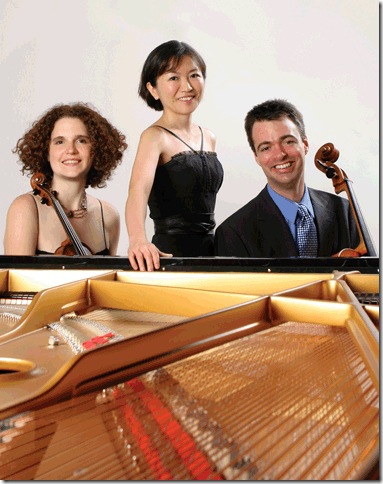Frederic Chopin did not write much chamber music, but it’s fair to say that the two major works that qualify — the early Piano Trio and the late Cello Sonata — have been too often overlooked.
In this bicentenary year of Chopin’s birth, the Connecticut-based Amelia Piano Trio is redressing that balance with performances of this fine work, and it was part of the bold, refreshingly innovative program the group brought to the Flagler Museum on Tuesday night.
The concert, which also featured works by Debussy, Shostakovich and Bernstein (as an encore), was well-conceived and grounded in a laudable spirit of exploration. Violinist Anthea Kreston told the sizable audience that she had read a letter Chopin wrote about the trio, in which he indicated he probably should have written it for viola instead of violin.
Kreston said she then tried both versions, violin and her own viola transcription, with the other members of the trio — cellist Jason Duckles (Kreston’s husband), and pianist Rieko Aizawa– and discovered that viola came out the winner, and that’s the way the Amelia does it.
And Kreston plays it beautifully; she has a commanding sound on the viola, and as promised, it meshes excellently with the sound of Duckles’ cello. Using the viola didn’t persuade me, ultimately, because much of the music of the trio needs the sharper cutting edge of the violin sound. The blend with the cello is too close, and the music loses too much distinction.
But it nevertheless was a wonderful performance of this music. Much of the first movement is dominated by the piano, and Aizawa did a fine job, from the crisp, precise way she played the jagged motif of the opening bars to the drive with which she performed its rolling figurations; it is essentially a study for the piano concertos the teenage Chopin was writing at the same time, and it came off beautifully.
The Scherzo second movement had a passionate intensity you don’t often hear in performances of Chopin, with the three-beats-to-a-bar main theme growing in urgency as it rose up the scale. That sense of big drama continued into the first measures of the slow movement, followed by lovely, fervent playing from Kreston and Duckles.
The finale had a strong folk-dance lilt that made it move, and added to earlier evidence that playing this trio with an overall vigor rather than dreaminess is the way to make it succeed, and the Amelias did that expertly. One day it would be nice to hear this group’s exciting reading of this trio with the violin instead.
The Chopin was one of four youthful trios on the program, and it was preceded by the lone piano trio of Claude Debussy, written during the summer of 1880, the year the composer turned 18. Debussy’s had been lost for nearly 100 years before being reconstructed in the 1980s, and it is a graceful, charming work in every respect. It doesn’t sound much like the mature composer (unlike Chopin’s trio), but it is quite attractive and a good addition to chamber music programs.
Although there is much that is nearly salon-like about this trio, the Amelia declined to read it that way, with marvelous results. This was a forceful, committed interpretation, one that paid good attention to rhythm and marked it out, such as in main theme of the Russian-flavored second movement, played here with clarity and delicacy by Aizawa, who set an engaging mood of freshness for the whole work in the initial bars of the first movement.
Duckles gave his third-movement solo warmth and high emotion, and in the finale, the threesome blended a brisk tempo and a big-hearted reading of the movement’s themes to end up with an impression of this work as a minor masterpiece: one with debts to Saint-Saëns and Massenet, but masterful nonetheless.
The concert opened with the first Shostakovich Piano Trio (in C minor, Op. 8), a one-movement work written when the composer was only 17, but already full of spiky harmonic language and a distinctive feeling of rapt melancholy. Quite different is the radiant second theme, played by the strings over murmuring chords in the piano.
The Amelias were particularly good at setting the hushed mood of the opening, with Aizawa putting up a background of quiet stasis as Duckles entered with the chromatic motif that binds the first section together. The ending, an over-the-top thundering of the second theme, is too obvious given the rest of the material, but the Amelias managed to make it persuasive.
For an encore, the trio played the second movement of Leonard Bernstein’s Piano Trio, written when he was a 19-year-old student at Harvard College. It begins with a bluesy pizzicato theme that turns into a dance, and it’s delightful. As with all the rest of the performances by this excellent ensemble, the playing was high-caliber and engaged, and it brought it audiences along confidently on its voyage of discovery.
The Intersection Trio, a piano trio, appears next in the Flagler Museum series with a concert on Tuesday, Feb. 23. Scheduled are the Mendelssohn Trio No. 2 (in C minor, Op. 66), arrangements of pieces by Elgar, Satie and Bizet, and solo works by Chopin, Sarasate and Cassadó. 7:30 p.m. Tickets: $60. Call 655-2833 or visit www.flaglermuseum.us.
